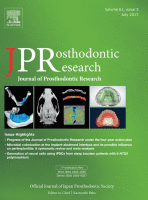Special Edition
Volume 61, Issue 3
Displaying 1-15 of 15 articles from this issue
- |<
- <
- 1
- >
- >|
Editorial
-
2017 Volume 61 Issue 3 Pages 231-232
Published: 2017
Released on J-STAGE: September 12, 2017
Download PDF (865K)
Review
-
2017 Volume 61 Issue 3 Pages 233-241
Published: 2017
Released on J-STAGE: September 12, 2017
Download PDF (787K)
Original Articles
-
2017 Volume 61 Issue 3 Pages 242-250
Published: 2017
Released on J-STAGE: September 12, 2017
Download PDF (1457K) -
2017 Volume 61 Issue 3 Pages 251-258
Published: 2017
Released on J-STAGE: September 12, 2017
Download PDF (5043K) -
2017 Volume 61 Issue 3 Pages 259-267
Published: 2017
Released on J-STAGE: September 12, 2017
Download PDF (1343K) -
2017 Volume 61 Issue 3 Pages 268-275
Published: 2017
Released on J-STAGE: September 12, 2017
Download PDF (642K) -
2017 Volume 61 Issue 3 Pages 276-282
Published: 2017
Released on J-STAGE: September 12, 2017
Download PDF (1210K) -
2017 Volume 61 Issue 3 Pages 283-289
Published: 2017
Released on J-STAGE: September 12, 2017
Download PDF (797K) -
2017 Volume 61 Issue 3 Pages 290-296
Published: 2017
Released on J-STAGE: September 12, 2017
Download PDF (365K) -
2017 Volume 61 Issue 3 Pages 297-304
Published: 2017
Released on J-STAGE: September 12, 2017
Download PDF (4294K) -
2017 Volume 61 Issue 3 Pages 305-314
Published: 2017
Released on J-STAGE: September 12, 2017
Download PDF (906K) -
2017 Volume 61 Issue 3 Pages 315-323
Published: 2017
Released on J-STAGE: September 12, 2017
Download PDF (1275K) -
2017 Volume 61 Issue 3 Pages 324-332
Published: 2017
Released on J-STAGE: September 12, 2017
Download PDF (1347K) -
2017 Volume 61 Issue 3 Pages 333-343
Published: 2017
Released on J-STAGE: September 12, 2017
Download PDF (2638K) -
2017 Volume 61 Issue 3 Pages 344-349
Published: 2017
Released on J-STAGE: September 12, 2017
Download PDF (731K)
- |<
- <
- 1
- >
- >|
